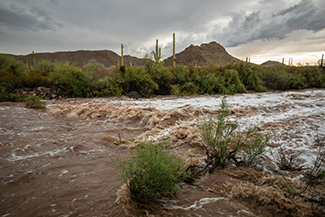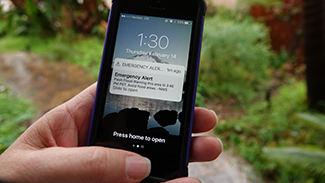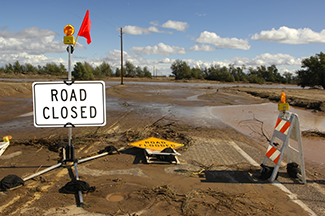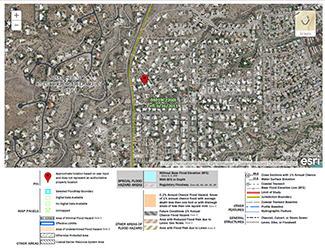Preparing and Riding Out Flash Floods
Preparing For and Riding Out Flash Floods
The weeks of July 19 and 26, 2021, were wet ones for Arizona. The rain came down hard for hours. KVOA News in Tucson reported on July 30th that "July 2021 has officially become the all-time wettest month in history. (Records go back to 1894). The extreme rain and dry soil were the perfect combinations for flash floods to occur – and they did, all over our state.
 The National Weather Service reports that in 2020, flooding claimed 57 lives in the U.S. Between 2010 and 2020, flash floods averaged 94 deaths a year, tied with tornadoes and heat for most weather-related deaths.
The National Weather Service reports that in 2020, flooding claimed 57 lives in the U.S. Between 2010 and 2020, flash floods averaged 94 deaths a year, tied with tornadoes and heat for most weather-related deaths.
In Arizona, rain is often met with cheer because of the moisture and cooler temperatures that come with it. Yet, monsoon storms can pack a punch and generate flooding that develops at speeds catching most people off guard. An arroyo (dry creek bed) can flood in a flash, thus the term “flash flood.”
Be Prepared
There are many things you can do to ensure your safety before the storm starts.
Before Flooding Occurs
Not sure if your area is susceptible or has a history of flooding? Visit FEMA’s Flood Map Service Center to find out. Call your insurance agent and ask about your property’s coverage.
In addition to protecting your property, keep vital documents in waterproof containers, move valuables to higher levels, and ensure your drains and gutters are not clogged.
If you are in a potential flood zone, get your hands on sandbags. They are available at most major hardware stores. Fire departments may have them as well.
Make sure your car is ready to go, too. Keep a spare battery, jumper cables, motor oil, jack, tire patch kit, and windshield wipers within easy access. See Romey’s Vehicle Preparedness Checklist for guidance.
Rosie’s Bug-Out Bag will come in handy for any reason you may have to bug out quickly and for longer than a day or two.
Just in case calamity strikes, you will need access to clean water, food, and other basic needs. Rosie’s Home Preparedness Guide will walk you through preparing everything you need at home.
Install a weather app such as Accuweather, The Weather Channel, National Weather Service on your phone or tablet that will send notifications for a particular weather alert such as these:

Flood Watch | Indicates flooding is possible. Stay by a trusted news source to watch for any developments.
Flash Flood Watch | Flash flooding is possible. Be prepared to move to higher ground or have a plan to do so if flooding occurs.
Flood Warning | Flooding is occurring or will occur soon.
Flash Flood Warning | Flash flood is occurring. Seek higher ground immediately.
During A Flooding Event
If authorities order evacuations, follow the order. When driving, do not bypass barriers. They are in place to mark areas of flooding that cannot be entered. The Arizona Emergency Information Network suggests if floodwaters rise around your car, abandon the car and move to higher ground if you can do so safely. Just six inches of moving water can knock you down, and one foot of moving water can sweep your vehicle away. One foot can wash your vehicle away. See “Stupid Motorist Law” below.
After The Flooding Event
Stay up to date with news and alerts regarding the storm and when it is safe to return to evacuated areas. Continue avoiding moving water and driving unless it is an emergency. Flooded conditions can last long after the cause of flooding has ceased.
Use caution when entering buildings as they may have sustained damage that is not visible. Stay on firm ground. Know the risk of electrocution in flooded areas. Do not approach or touch anything electrical if you are standing in water.
Don’t write these precautions off. Arizona is no stranger to epic flooding events.
Stupid Motorist Law
 If you are new to Arizona, you may not have heard about our “ Stupid Motorist Law .” It’s a real thing.
If you are new to Arizona, you may not have heard about our “ Stupid Motorist Law .” It’s a real thing.
Per the law, “A driver of a vehicle who drives the vehicle on a public street or highway that is temporarily covered by a rise in water level, including groundwater or overflow of water, and that is barricaded because of flooding is liable for the expenses of any emergency response that is required to remove from the public street or highway the driver or any passenger in the vehicle that becomes inoperable on the public street or highway or the vehicle that becomes inoperable on the public street or highway, or both.”
In layman’s terms, if you drive into a flooded area that is clearly marked and barricaded, and you need a rescue, you’re footing the rescue bill. BONUS: your name and face will show up all over the news and social media, and everyone will know you are a “Stupid Motorist.” Just turn around and find an alternative route. Don’t put yourself, your passengers, or the rescuers in danger.
Play it safe. Be prepared and follow instructions from authorities. Enjoy the rain safely.
Home Maintenance To-Do | Avoid a #FlashFlood
###
Podcast
What is a Vortex Vault? We'll tell you! Plus, we talk about home elevators. We cover listener questions on ductless air conditioners or mini-splits, woodpeckers damaging stucco, grass around a fruit tree and drain pipe install in a new built home that called for cutting into the slab - There is a difference between the foundation and the slab. In addition, we provide more information on our Weekly To Do: preparing and avoiding Flash Floods.
Photo Credits
- Shutterstock

